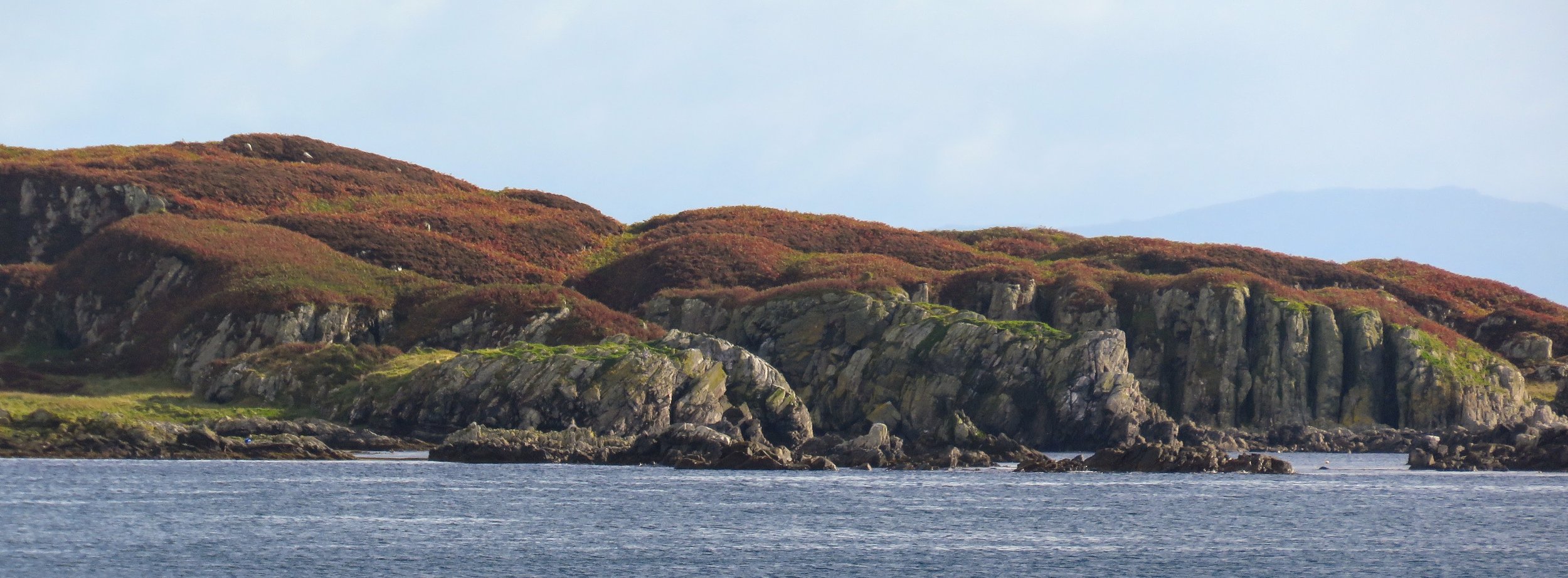Ancient Sites and Memorials
Day 6: Piles of Rocks
Day 6 saw us leaving the Isle of Islay and smoky scotch and making our way slowly north. En route, we saw the historic docks for three of the distilleries (the large block letters made it easier for ship captains to identify the right dock), some wildlife, piles of old rocks, and a weeping valley.
Leaving the Isle of Scotch
"The fertile, largely treeless island of Islay (pronounced "eye-la") is famous for one thing -- single-malt whisky. {And I tried as many as possible.} In medieval times, Islay was the political center of the Hebrides, with Finlaggan, near Port Askaig, the seat of the McDonalds, Lords of the Isles. The picturesque, whitewashed villages you see on Islay today, however, date from the planned settlement founded by the Campbells in the late eighteenth and early nineteenth centuries."
~ Rough Guide to Scotland




































Dunadd Fort
"Moine Mhor is best known as the home to the Iron Age fort of Dunadd, one of Scotland's most important Celtic sites, occupying a distinctive 176-ft high rocky knoll once surrounded by the sea but currently stranded beside the winding River Add. It was here that Fergus, the first king of Dalriada -- which embraced much of what is now Argyll -- established his royal seat, having arrived from Ireland in around 500 A.D. Its strategic position, the craggy defense and the view from the top are all impressive, but it's the stone carvings between the twin summits which make Dunadd so remarkable: several lines of inscription in Ogham (an ancient alphabet of Irish origin), the faint outline of a boar, a hollowed-out footprint and a small basin. The boar and the inscription are probably Pictish, since the fort was clearly occupied long before Fergus got there, but the footprint and basin have been interpreted as being part of the royal coronation rituals of the kings of Dalriada. It is thought that the Stone of Destiny was used at Dunadd before being move to Scone Palace."
~Rough Guide to Scotland



















Kilmartin Glen
"Four to five thousand years ago, Kilmartin Glen was inhabited by Neolithic people who left behind fragments of their giant, stony monuments. And 1,500 years ago, this was the seat of the kinds of the Scoti, who migrated here from Ireland around A.D. 500, giving rise to Scotland's own branch of Celtic culture. From this grassy valley, the Scoti kings ruled their empire, called Dalriada (also sometimes written as Dal Riata)."
~Rick Steve's Scotland






Nether Largie South Cairn




Temple Wood Circle





Dunollie Castle
"This spartan, stocky castle with 10-foot walls is a delightful stroll from the town center. The ruins offer a commanding, windy view of the harbor -- a strategic spot back in the days when transport was mainly by water. For more than a thousand years, clan chiefs ruled this region from this ancestral home of Clan MacDougall, but the castle was abandoned in 1746. The adjacent home, which dates from 1745, shows off the MacDougall clan's family heritage -- much of it naval."
~Rick Steves' Scotland








Castle Stalker
"Framed magnificently as you wind along the single-track road to Port Appin is one of Argyll's most romantic ruined castles, the much-photographed sixteenth-century ruins of Castle Stalker. Privately owned, the castle can only be visited on a pre-booked tour. Otherwise, there is a footpath from the Castle Stalker View cafe that winds down to a point some 200 yards from the castle, affording some cracking photo opportunities."
~Rough Guide to Scotland



Glen Coe
"Breathtakingly beautiful Glen Coe (literally "Valley of Weeping"), sixteen miles south of Fort William on the A82, is a spectacular mountain valley between velvety-green conical peaks, their tops often wreathed in cloud, and their flanks streaked by cascades of rock and scree.
"By the time you've reached the heart of the glen, with the huge rock buttresses known as the Three Sisters on one side and the Anoach Eagach ridge on the other combining to close up the sky, you'll almost certainly want to stop."
~Rough Guide to Scotland





















Glen Coe Memorials
"In 1692 Glen Coe was the site of a notorious massacre, in which the MacDonalds were victims of an abiding government desire to suppress the clans. Fed up with what they regarded as unacceptable lawlessness, and a groundswell of Jacobitism and Catholicism, the government offered a general pardon to all those who signed an oath of allegiance to William III by January 1, 1692. When clan chief Alastair MacDonald missed the deadline, a plot was hatched to make an example of "that damnable sept", and Campbell of Glenlyon was ordered to billet his soldiers in the homes of the MacDonalds, who for ten days entertained them with traditional Highland hospitality. In the early morning of February 13, the soldiers turned on their hosts, slaying around forty people and causing more than three hundred to flee in a blizzard."
~Rough Guide to Scotland

Dessert is the Best








